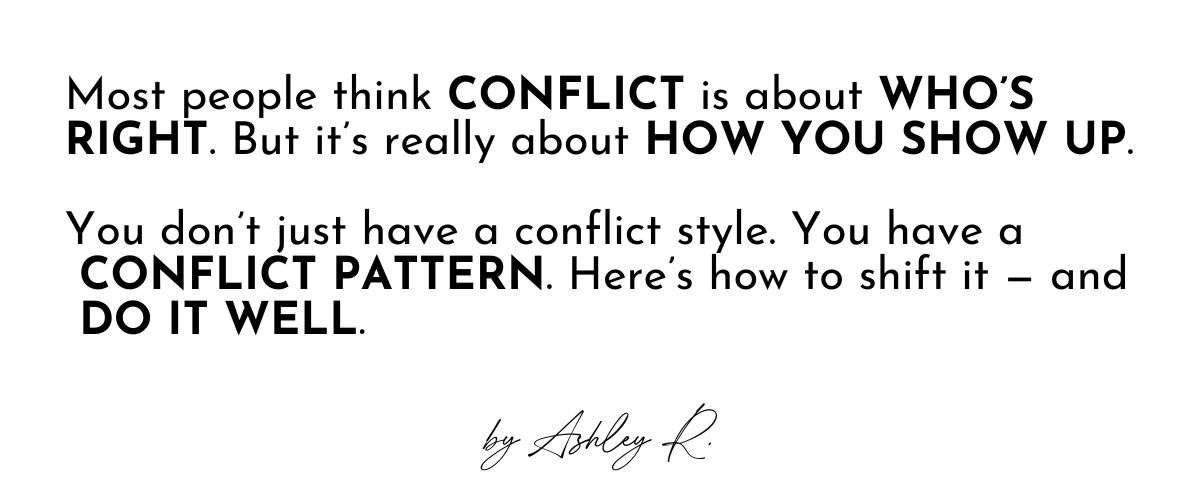Forget What You Know About Navigating Conflict at Work
Being great at your job doesn’t always mean you’re great at handling conflict. Here’s how to get it right.
Today we’re talking about a topic that can leave people feeling deeply uncomfortable: conflict.
After years of blundering conflict myself, a lightbulb clicked for me when I was leading a PMO. If you know anything about project management, it’s a job that puts you right at the center of conflict. The best project managers are able to diffuse tensions on a team and find ways to resolve conflict in order to keep the work on track. I learned a lot leading that team and it reframed the way I think about and manage conflict myself.
When you’re working with other people, conflict is to be expected. It’s normal and it can be healthy. And sometimes, it’s not.
Conflict at work isn’t always explosive. Sometimes it just lingers quietly.
Maybe it sounds like a sharpness in your voice when you’re thinking “why am I explaining this for the 10th time?!”. Or maybe it’s the way one name in your inbox makes your shoulders tense up.
If you’re someone who prides yourself on excellence or if you’re the type of person who likes things buttoned up, done right, and even done early?
Conflict doesn’t just feel uncomfortable. It can feel like someone is questioning your value or your competence.
And when that happens, you do what high performers often do in conflict:
You shut down or grab your receipts.
I’ve seen this dynamic play out countless times. And as I sat down to write this post, one story came to mind.
THE SCENE: STORY TIME
The Retreat That Didn’t Need an Intervention
A few months ago, I was brought in to facilitate a leadership retreat for a high-performing team. I designed three days of custom content to help them work better together, deepen trust, and build on the strong foundation they already had.
What I didn’t know until I arrived was that two colleagues, let’s call them Jordan and Cam, were barely speaking. Their manager had scheduled a mediation for the Saturday after the retreat. A calendar block that said, "now that we’re all together, we have to address the elephant in the room."
Throughout the retreat they avoided eye contact. One would speak and the other would glance away. They sat on opposite sides of the room. When we broke into small groups, they made sure not to land in the same one.
But across those three days, something shifted.
They weren’t pulled into a facilitated breakthrough. They weren’t assigned a conflict resolution activity. They were just... there. Participating. Listening. Building ideas alongside each other.
And slowly, the tension softened.
On day three, during one of the breaks, they were talking. Not just politely, they were laughing. By the end of the retreat, they went to their manager and said, "You can cancel Saturday. We talked. We’re good.”
It wasn’t magic. It wasn’t even intentional. But it worked. Because they stopped seeing each other as threats. They remembered they were on the same team.
SUBSCRIBE
→ Already subscribed? You’re in good company.
My readers work at places like A24, DoorDash, IDEO, Disney, and Harvard — and they’re all here for the same reason: to lead with more clarity, confidence, and intention. If you’re not subscribed, click the subscribe button below.
THE FRAMEWORK FOR SOLVING CONFLICTS AT WORK
The Conflict Grid: Evaluating Yourself in Conflict
That retreat I facilitated wasn’t the resolution. Yes, we all now know I’m amazing (lol) but the breakthrough wasn’t about me. It was about the environment. The space.
The reset.
The whole thing made me realize something: conflict isn’t just about who’s right. It’s about how you show up. Because when you’re under pressure, when you’re tired, and when the stakes are high, you don’t rise to your ideals, you default to your patterns. And if you don’t know what those patterns are? There’s a chance that you’ve encountered unresolved conflicts.
Most people don’t realize how much power they have to shape conflict because they’re not evaluating themselves. They’re reacting.
Here’s how to change that.
I created this simple framework after seeing patterns in how high achievers navigate conflict. Use it at work, at home, with friends…the awareness changes you.
Start by asking yourself two questions:
1. Am I willing to engage?
Are you naming the tension? Saying the hard thing? Staying in the room even when it gets messy?
This is your mindset — a spectrum from avoiding the hard things to willingness to say the hard things.
2. How am I engaging?
Are you trying to drive the outcome? Control the space? Or are you making room for collaboration?
This is your presence — a spectrum from taking control to collaborating with others.
You’ll want to screenshot this matrix →
Now let’s walk through the quadrants on the matrix and what they mean.
Bottom left: Avoiding the hard things + Taking control
You’re not naming the tension, but you’re trying to steer the ship anyway. That might look like micromanaging, reassigning work, or rewriting the deck yourself at 2am. The issue gets redirected, not resolved.
It’s still technically “productive,” but something’s off. Your team starts to sense your frustration even if you never say it out loud. And without context, your leadership starts to feel confusing — or worse, controlling.
Make this shift →
Try addressing the issue directly and without blame by saying “We’re not on the same page, let’s talk through what’s happening and where to go from here.”
Top left: Avoiding the hard things + Collaborating with others
You’re the one everyone depends on, not because you have the time, but because you always make it work. You nod through the meeting, say “happy to help”, and quietly carry more than your share. You don’t speak up because it feels easier to hold it in than to prioritize (or hold a boundary).
But quiet agreement isn’t the same as alignment. Eventually, your yes becomes a weight. And even if no one else can see it, you feel the slow burn of resentment starting to simmer.
Make this shift →
Instead of defaulting to yes, try advocating for yourself by prioritizing. Say “I’m happy to take this on, but I’ll need to adjust some priorities. Can we walk through that together?”
Bottom right: Willing to say hard things + Taking control
You spot the problem, name it fast, and move straight to solutions. You’re decisive, strategic, in control. And while that feels efficient…it can also leave people behind. You’re doing most of the talking. You’re skipping past nuance. You’re running the meeting, but losing the room. Maybe you’re even stepping on toes.
It’s not that your ideas are wrong. You’re just rushing. And when you lead from urgency instead of awareness, even good decisions don’t always land.
Make this shift →
You can make space for others by asking a simple question. Try framing your recommendations as “Here’s what I’m thinking, what am I missing?”
Top right: Willing to say hard things + Collaborating with others
This is the ideal conflict scenario. You’re grounded enough to be direct, open enough to stay curious. You’re not afraid of tension because you know it’s where real progress happens. You say the hard things with care. You listen without retreating. You’re not trying to win the argument, you’re trying to get it right — together.
This is what Cam and Jordan shifted into at the retreat. Not because someone forced a breakthrough, but because the space gave them room to relate again. Sometimes all it takes is remembering you’re on the same team.
Why this works:
Teams that engage in healthy conflict understand that they might not see things the same way but they want to understand each others’ POVs and figure out solutions together.”
THE WRAP UP
Most people don’t know their conflict management strategies aren’t working until it’s already cost them something.
A relationship.
A reputation.
A role they didn’t get and weren’t told why.
I’ve been there. And if I’m honest, there are still moments I look back on and cringe. Not because I didn’t care, but because I didn’t know how to show up differently.
That’s the thing about growth: it sneaks up on you. One day you’ll look up and realize you’re not managing tension the way you used to. You’re pausing. Naming things. Maybe even choosing connection over control.
Now that you have the tools, my only question is: how do you want to show up next time?
Good luck! See you next week.
Ashley
Work with me
Because knowing better isn’t the same as doing differently.
You don’t need more insight. You need support. A sounding board. A strategy. A different way through.
For Individuals
You’re great at the work. You hit your goals. But when conflict shows up? You over-function. You carry too much. You question if you’re the problem.
I coach high-achieving people who are ready to stop managing tension by themselves — and start leading through it with clarity, calm, and confidence.
If this post hit a little too close to home, you don’t have to figure it out alone.
Click here to learn more about my program →
For Teams
If your team has been tense, off-track, or just a little… off, let’s fix that.
I facilitate offsites, workshops, and leadership retreats designed to build real trust. Not just talk about it.
If you’re a manager, founder, or people leader who read this and thought “Yeah… we need this” — let’s talk.
Click here to inquire about team sessions or retreats →






